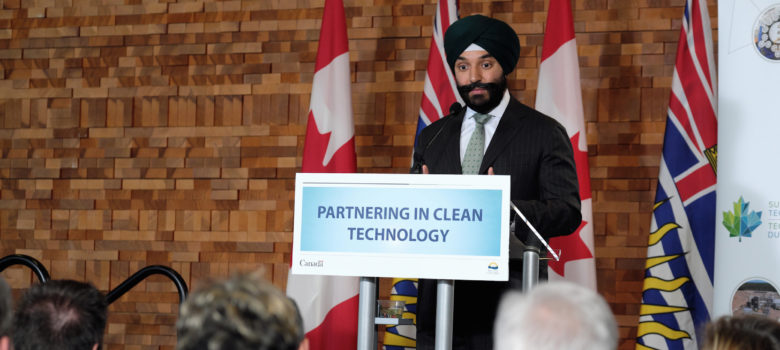The release of today’s federal budget is expected to include a significant emphasis on innovation, with the government revealing how it plans to spend (or re-allocate) hundreds of millions of dollars that is intended to support innovation. Canada’s dismal innovation record needs attention, but spending our way to a more innovative economy is unlikely to yield the desired results. While Navdeep Bains, the Innovation, Science and Economic Development Minister, has talked for months about the importance of innovation, Toronto Star columnist Paul Wells today delivers a cutting but accurate assessment of those efforts:
This government is the first with a minister for innovation! He’s Navdeep Bains. He frequently posts photos of his meetings on Twitter, with the hashtag “#innovation.” That’s how you know there is innovation going on. A year and a half after he became the minister for #innovation, it’s not clear what Bains’s plans are. It’s pretty clear that within the government he has less than complete control over #innovation. There’s an advisory council on economic growth, chaired by the McKinsey guru Dominic Barton, which periodically reports to the government urging more #innovation.
There’s a science advisory panel, chaired by former University of Toronto president David Naylor, that delivered a report to Science Minister Kirsty Duncan more than three months ago. That report has vanished. One presumes that’s because it offered some advice. Whatever Bains proposes, it will have company.
Wells is right. Bains has been very visible with plenty of meetings and public photo shoots but no obvious innovation policy direction. This represents a missed opportunity since Bains has plenty of policy tools at his disposal that could advance Canada’s innovation framework without focusing on government spending.
For example, Canada’s communications system – wireless and broadband Internet access – falls directly within his portfolio and is crucial for both business and consumers. Yet Bains has been largely missing in action on the file. He gave approval for the Bell – MTS merger that virtually everyone concedes will increase prices in the province and make the communications market less competitive. There are potential policy measures that could bring new competitors into the market (MVNOs and municipal broadband) and that could make it easier for consumers to switch providers (ban on unlocking devices). Some of this falls to the CRTC, but government direction and emphasis would make a difference.
Even more troubling has been his near total invisibility on issues relating to new fees or taxes on Internet access and digital services. Canadian Heritage Minister Melanie Joly has taken control of the issue with the possibility that Canadians could face increased costs for their Internet access or digital services through mandatory fees to contribute to Canadian content. Leaving aside the policy objections to such an approach (reducing affordable access and the fact that foreign sources now contribute more toward Canadian English language TV production than Canadian broadcasters and distributors), Internet access and e-commerce are supposed to be Bains’ issue and they have a direct connection to the innovation file. How is it possible for the Innovation, Science and Economic Development Minister to have remained silent for months on the issue?
Bains has been largely missing on trade related innovation issues as well. My Globe and Mail column today focuses on a digital-era NAFTA, pointing to likely U.S. demands on data localization, data transfers, e-commerce rules, and net neutrality. These are all issues that fall under Bains’ portfolio and will impact investment in Canadian networks and digital services. There are innovation opportunities for Canada here, but Bains has been content to leave the policy issues to others, who will be willing to sacrifice potential gains in those areas.
Intellectual property policy is yet another area that falls directly under Bains’ mandate with an obvious link to innovation, but he has done little on the file. Canada won a huge NAFTA victory late last week involving the Canadian patent system, which was challenged by pharmaceutical giant Eli Lilly. Why has Bains not promoted the decision as an affirmation of how Canada’s intellectual property rules?
On the copyright front, the government is scheduled to conduct a review of the Copyright Act later this year, but it is not clear whether Bains will take the lead or again cede responsibility to Joly. The Copyright Act is statutorily under the Industry Minister and reform offers the chance to kickstart innovation. For example, Canada could adopt fair use rules that have been critical for innovative economies such as the United States, Israel, South Korea, and Singapore. When coupled with the restrictive digital lock rules that suffer from narrowly interpreted exceptions, the Canadian copyright law environment is supportive of cracking down on infringement but lacks the flexibility needed for new creativity and innovation. This represents an enormous opportunity for Bains to create a policy framework that supports innovation without new taxes or public expenditures.
There are no shortage of other opportunities that fall within the ISED mandate: leveraging government-funded research with open access policies, improving open data, and addressing cyber-security opportunities among them. In fact, many of these issues were included in Bains’ mandate letter. Nearly 18 months after the release of that letter, Canadians are still waiting for the promised “real change”.








thanks for the info
Pingback: Budget 2017: Why Canada's Digital Policy Future Is Up For Grabs - Michael Geist